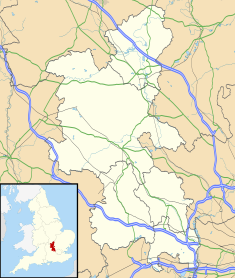
High Wycombe, often referred to as Wycombe, is a market town in Buckinghamshire, England. Lying in the valley of the River Wye surrounded by the Chiltern Hills, it is 29 miles (47 km) west-northwest of Charing Cross in London, 13 miles (21 km) south-southeast of Aylesbury, 23 miles (37 km) southeast of Oxford, 15 miles (24 km) northeast of Reading and 8 miles (13 km) north of Maidenhead.
Charles Cowles-Voysey was an English architect.
Wycombe Rural District was, from 1894 to 1974, a rural district in the administrative county of Buckinghamshire, England.
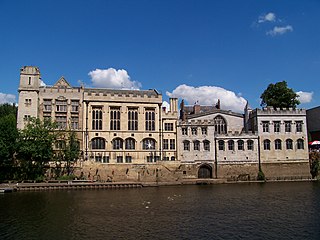
York Guildhall is a municipal building located behind York's Mansion House. It is a Grade I listed building.
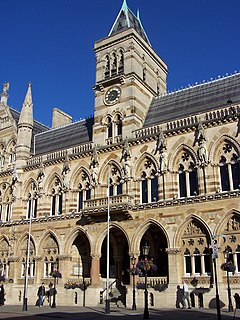
Northampton Guildhall is a municipal building in St Giles' Square in Northampton, England. It is a Grade II* listed building.
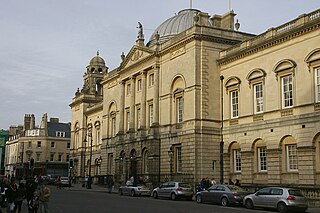
Guildhall is an 18th-century municipal building in central Bath, Somerset, England. It is a Grade I listed building.
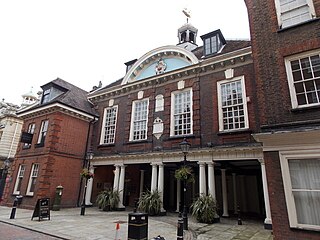
The Rochester Guildhall is an historic building located in the High Street in Rochester, Kent, England. It is a Grade I listed building.
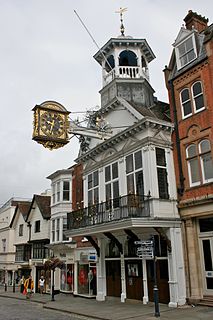
The Guildford Guildhall is a Guildhall located on the High Street of the town of Guildford, Surrey. It is a Grade I listed building.
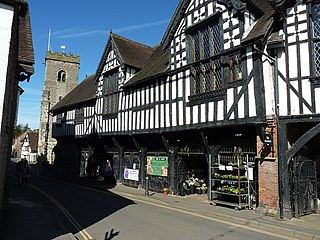
The Much Wenlock Guildhall is a guildhall located on Wilmore Street in Much Wenlock, Shropshire. It is a Grade II* listed building.

The Guildhall is a town hall and community building in the town of Chard in the English county of Somerset.

The Worcester Guildhall is a municipal building in the High Street, Worcester, England. It is a Grade I listed building.
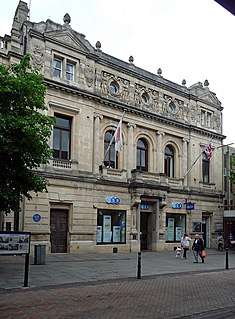
Gloucester Guildhall is a former municipal building in Eastgate Street, Gloucester, which is now used as a arts and theatre venue. It is a Grade II listed building.

Walsall Council House is a municipal building in Lichfield Street in Walsall, West Midlands, England. It is a Grade II listed building.

High Wycombe Town Hall is a public building located on Queen Victoria Road in High Wycombe, Buckinghamshire, England. The building, which is used as an events venue, is a Grade II listed building.

Evesham Town Hall is a municipal structure in the Market Place in Evesham, Worcestershire, England. The town hall, which was the headquarters of Evesham Borough Council, is a Grade II listed building.

Newport Guildhall is a municipal structure in the High Street in Newport, Isle of Wight, England. The guildhall, which was the headquarters of Newport Borough Council, is a Grade II* listed building.
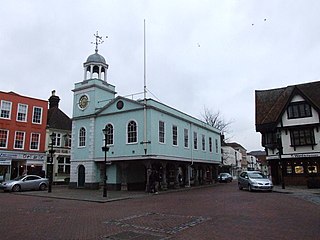
Faversham Guildhall is a municipal building in the Market Place in Faversham, Kent, England. The structure, which was the meeting place of Faversham Borough Council, is a Grade II* listed building.

Liskeard Guildhall is a municipal building in Pike Street, Liskeard, Cornwall, England. The structure, which was the meeting place of Liskeard Borough Council, is a Grade II* listed building.

Chipping Norton Town Hall is a municipal building in the Market Place, Chipping Norton, Oxfordshire, England. The building, which is used as an events venue, is a Grade II* listed building.

The Municipal Offices are located on Queen Victoria Road in High Wycombe, Buckinghamshire, England. The structure is used as the High Wycombe local area office of Buckinghamshire Council.

